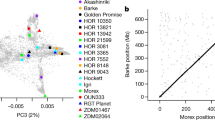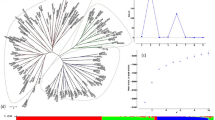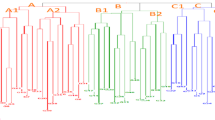Abstract
The procedures of biometrical genetics have been used to detect and analyse reciprocal differences for the response of immature barley embryos to 2,4-dichlorophenoxyacetic acid in culture. Two genotypes were examined (4082 and R23) which had exhibited large reciprocal differences in culture in previous experiments. The F1, F2 and backcross generations, including full reciprocal families, were produced from these, true-breeding genotypes and evaluated in culture. The experiments confirmed the presence of reciprocal differences. Such differences were subsequently shown to stem from cytoplasmic effects alongside effects traceable to the mother tissue. The implications of these findings for the manipulation of barley genotypes in vitro are discussed.
Similar content being viewed by others
Article PDF
References
Armstrong, K C, Nakamura, C, and Keller, W A. 1983. Karyotype instability in tissue culture régénérants of Triticale (Triticosecale Wittmack) cv. “Welsh” from 6 months old callus culture. Z Pflanzenzucht, 91, 233–245.
Beckert, M, and Qing, C M. 1984. Results of a diallel trial and a breeding experiment for in vitro aptitude in maize. Theor Appl Genet, 68, 247–251.
Bright, S W J. 1985. Selection in vitro. In Bright, S. W. J. and Jones, M. J. K. (eds.) Cereal Tissue and Cell Culture, Martinus Nijhoff/Dr. W. Junk, pp. 232–260.
Caligari, P D S, Powell, W, and Jinks, J L. 1985. The USe of doubled haploids in barely breeding. 2. An assessment of univariate cross prediction methods. Heredity, 54, 353–358.
Caligari, P D S, Powell, W, and Goodall, V. 1987. The in vitro genetics of barley (Hordeum vulgare L.): Genetical analysis of immature embryo response to 2,4-dichloro-phenoxyacetic acid. Heredity, 59, 285–292.
Jayasekara, N E M, and Jinks, J L. 1976. Effects of gene dispersion on estimates of components of generation means and variances. Heredity, 36, 31–40.
Jinks, J L. 1964. Extrachromosomal Inheritance, Prentice-Hall, London.
Jinks, J L, Perkins, J M, and Gregory, S R. 1972. The analysis and interpretation of differences between reciprocal crosses of Nicotiana rustica varieties. Heredity, 28, 363–377.
Jinks, J L, and Pooni, H S. 1976. Predicting the properties of recombinant inbred lines derived by single seed descent. Heredity, 36, 253–266.
Keyes, G J, and Bingham, B T. 1979. Heterosis and ploidy effects on the growth of alfalfa callus. Crop Sci, 19, 473–476.
Keyes, G J, Deaton, W R, Collins, G B, and Legg, P D. 1981. Hybrid vigour in callus tissue cultures and seedlings of Nicotiana tabacum L., J Hered, 72, 172–174.
Larkin, P J. 1985. In vitro culture and cereal breeding. In Bright, S. W. J. and Jones, J. J. K. (eds) Cereal Tissue and Cell Culture, Martinus Nijhoff/Dr. W. Junk, pp. 274–296.
Lazar, M D, Collins, G B, and Vian, W E. 1983. Genetic and environmental effects on the growth and differentiation of wheat somatic cell cultures. J Hered, 74, 353–357.
Mather, K, and Jinks, J L. 1982. Biometncal Genetics, 3rd edition. Chapman and Hall, London.
Mathias, R J, and Fukui, K. 1986. The effect of specific chromosome and cytoplasm substitutions on the tissue culture response in wheat (Triticum aestivum) callus. Theor Appl Genet, 71, 797–800.
Mathias, R J, Fukui, K, and Law, C N. 1986. Cytoplasmic effects on the tissue culture response of wheat (Triticum aestivum) callus. Theor Appl Genet, 72, 70–75.
Murashige, T, and Skoog, F. 1962. A revised medium for rapid growth and bioassays with tobacco tissue cultures, Physiol Plant, 15, 473–497.
Nesticky, M, Novak, F J, Piovarci, A, and Dolezelova, M. 1983. Genetic analysis of callus growth in maize (Zea mays L.) in vitro. Z Pflantzenzucht, 91, 322–328.
Pope, M N. 1944. Some notes on techniques on barley breeding. J Hered, 35, 99–111.
Powell, W, Caligari, P D S, McNicol, J W, and Jinks, J L. 1985. The use of doubled haploids in barley. 3. An assessment of multivariate cross prediction methods. Heredity, 55, 249–254.
Powell, W, and Dunwell, J M. 1987. In vitro genetics of barley (Hordeum vulgare L.) 1. Response of immature embryos to 2,4-dichlorophenozyacetic acid. Heredity, (in press).
Smith, H H, Rao, K N, and Combatti, M C. 1976. Interspecific hybridisation by protoplast fusion in Nicotiana: confirmation and extension. J Hered, 67, 123–128.
Tabata, M, and Motoyoshi, F. 1965. Hereditary control of callus formation in maize endosperm cultured in vitro. Japan J Genet, 40, 343–355.
Tomes, D T, and Smith, O S. 1985. The effect of parental genotype on initiation of embryogénie callus from elite maize (Zea mays L.) germplasm. Theor Appl Genet, 70, 505–509.
Author information
Authors and Affiliations
Rights and permissions
About this article
Cite this article
Powell, W., Caligari, P. The in vitro genetics of barley (Hordeum vulgare L.): detection and analysis of reciprocal differences for culture response to 2,4-dichlorophenoxyacetic acid. Heredity 59, 293–299 (1987). https://doi.org/10.1038/hdy.1987.126
Received:
Issue date:
DOI: https://doi.org/10.1038/hdy.1987.126
This article is cited by
-
Genetic analysis of sodium content and Na/K ratio in relation to salinity tolerance in pearl millet Pennisetum glaucum (L.) R. Br.
Journal of Crop Science and Biotechnology (2012)
-
Is heterosis noticeable in the callus response of winter durum wheat F1 hybrids?
Biologia plantarum (2010)
-
Genetic analysis of in vitro callus and production of multiple shoots in eggplant
Plant Cell, Tissue and Organ Culture (PCTOC) (2010)
-
The effect of hybrid vigor on callus induction and plant regeneration from mature embryo culture of barley (Hordeum vulgare)
Plant Cell, Tissue and Organ Culture (2005)
-
Somatic in vitro culture response of Lolium perenne L.: genetic effects and correlations with anther culture
Euphytica (1995)



